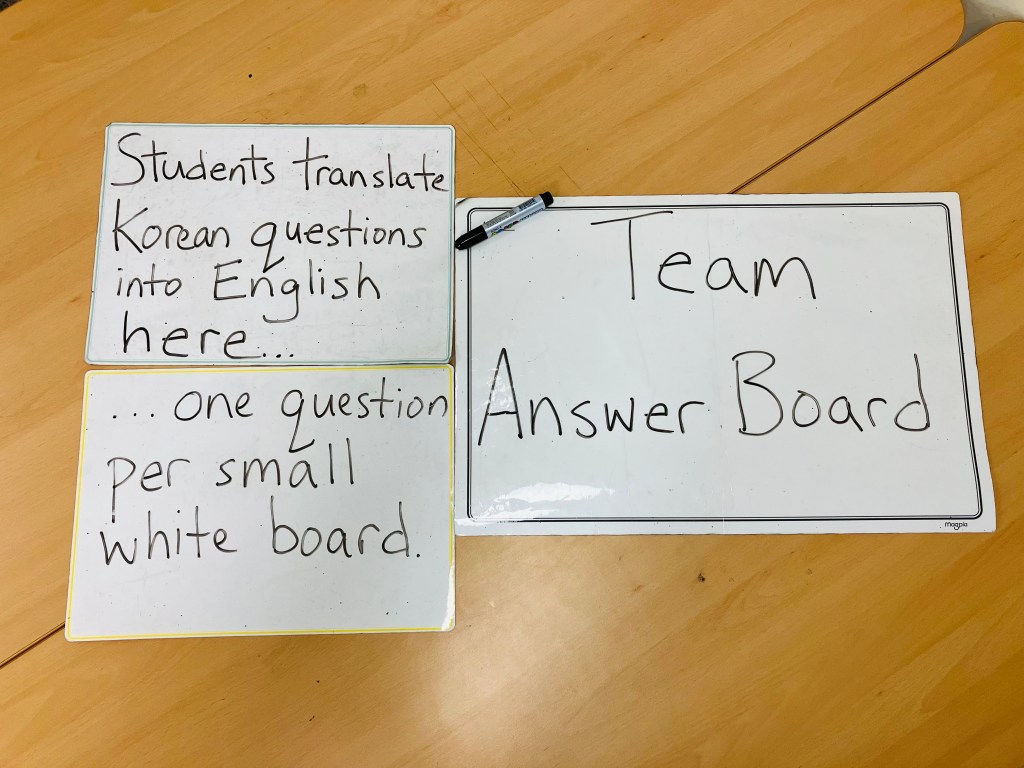QUESTION: Which ELL teacher needs a great end-of-the-year lesson structure? ANSWER: All of us. Check out this trivia game ELL lesson, which keeps students connected to English after final exams. It gives students a brief and manageable task to start class, and engages them in a game that requires reading, writing, listening, and speaking. Modify it to fit your classroom and the students you teach.
Level: Intermediate
Time: 50 minutes (though 1 full hour would be great!)
Of course, there are many ways to make a trivia game. But after lots of trial and error, I have discovered the best way (for the population of students I teach), which I’ve detailed below. But first, here’s a video version of one game’s PPT. And here’s a link to download the PPT.
*PRE-CLASS
- All of the heavy lifting for this lesson comes before class. I create 10 trivia questions with several goals in mind:
- My students are science high school students, so I make sure to include some science-related questions.
- I usually lead with a question that allows all teams to score some points, so they “get on the board” early and build some momentum and confidence. Questions that have multiple answers are good for this.
- Some of the questions should have numerical or date answers. Again, this allows multiple teams to earn points – most points for closest answer, some points for next closest, and so on.
- I aim to make questions that about 40% of students will answer correctly. It doesn’t always work out like this, but I find this to be a very useful heuristic.
- Whenever possible, I try to choose “timeless” questions, so they can be used indefinitely with future classes without a lot of time and effort to update.
- I think of fun, related follow-up or “Bonus” questions to insert into the game between official questions.
- Once I have my questions, I translate them into Korean and print the Korean versions on strips of paper.
- If you have access to individual magnetic white boards (see below), they are a wonderful tool, both in general and particularly for this lesson.
- You can let each team make a name, or just assign team names as I did here, to save some time. Fans of 이상한 변호사 우영우 might notice something interesting about the team names.
I. TRANSLATION (~5 mins)
- I have about 20 students in my classes, so I put students in 5 groups of 4. I give each table 2 small white boards and 1 large white board. Then I walk them through their task, with a PPT slide.

- Finally, I hand out the question strips (2 questions to each table of 4 students) and have the students translate them from Korean into English, encouraging all tablemates to help each other.


II. GAMEPLAY (~45 mins)
- We start the game after students have translated all questions. A student from the table with Question Number 1 brings their question board up, reads it aloud, then sits down.
- I show my English translation of the question on the screen, and then all teams write their answers on their Team Answer board.
- While teams are answering, I highly recommend playing some music to keep teams from overhearing other teams’ answers. I use a simple Bluetooth speaker, which I easily control with my phone.

- Play the game through to the end, keeping score as you go. If you’re not able to complete all questions in time, no problem. Check final scores and award the winning team … OR …
- It’s a tradition in my class, at the end of any game we play, to give each team one chance to throw a large foam die. 6 is 60 points, 5 is 50, and so on. But 1 is a bomb, which means the team loses all points. I love this way to end a game for a couple reasons:
- It gives every team at least a small chance to win, even if they struggle during the game.
- It creates suspense and joy and movement, as students throw the die and watch it roll around, before it comes to rest.


